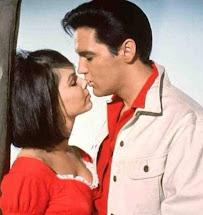1. Yvonne Craig studied ballet at age 16 as the youngest member of The Ballet Russe de Monte Carlo. After three years, she left the company and wound up cast opposite Patrick Wayne (John's son) in 1959's
The Young Land. Craig occasionally got opportunities to display her dancing skills in film and TV, most notably as a Russian ballerina dancing with James Coburn in the spy spoof
In Like Flint (1967).
2. In the 1959 pilot episode of The Many Loves of Dobie Gillis, Yvonne Craig appeared in the opening credits in which Dobie (Dwayne Hickman) peeks through a hole in a fence at her and Myrna Fahey. When the series was picked up, that opening was replaced with an animated sequence of Dobie and the girls. Still, Yvonne guested on Dobie Gillis five times, playing characters such as rich girl Linda Sue Faversham.
 |
| Batgirl with the Boy Wonder. |
3. In 1968, ABC considered launching a
Batgirl TV series with Yvonne Craig as the title character. A short "pilot" was produced, which also featured Batman (Adam West) and Robin (Burt Ward). Batgirl saves the Dynamic Duo from the Killer Moth, who traps them in a cocoon. When ABC rejected the idea of a separate series, Yvonne Craig's Batgirl was incorporated into the last season of
Batman. For many years, the
Batgirl pilot was available only on bootleg copies, but it was included as a bonus feature in a 2014
Batman boxed set.
4. Craig embraced her role as Batgirl. In a 2015 CNN interview, she stated: "I hear from women that I was their role model. When I was a little girl, I realized that girls could kick butt just like guys." She also found the experience to be a rewarding one. "I got to work with people that I would never have the chance to work with. We had Ethel Merman. I would never have met Milton Berle, I got to work with him, and he was a delight."
 |
| As Marta in Star Trek. |
5. Yvonne Craig was a frequent guest star in 1960s and 1970s TV series, appearing in shows such as
The Courtship of Eddie's Father,
My Three Sons,
77 Sunset Strip, and
Ben Casey (with one-time boyfriend Vince Edwards). She also starred in a third season episode of the original
Star Trek series called "Whom Gods Destroy." She played a green-skinned female Orion--but she's not the green woman shown in
Star Trek's closing credits. That's Susan Oliver in the guise of another Orion from the famous two-part episode "The Menagerie."
 |
| With Elvis in Kissin' Cousins. |
6. Yvonne Craig and Deborah Walley shared several connections. Each of them appeared in a
Gidget movie: Yvonne had a small role in the 1959 original and Deborah played the lead in
Gidget Goes Hawaiian (1961). Deborah Walley appeared in the Beach Party movies
Beach Blanket Bingo and
The Ghost in the Invisible Bikini; Yvonne Craig appeared with Walley in the Frankie Avalon comedy
Ski Party (1965). Yvonne starred with Elvis in two films:
It Happened at the World's Fair (1963) and
Kissin' Cousins (1964). Deborah Walley appeared with Elvis in
Spinout (1966). Later in their careers, each actress voiced characters in animated TV series: Walley in
Chip 'n' Dale Rescue Rangers and Yvonne Craig in
Olivia.
7. Yvonne Craig was married twice. The first marriage was to singer Jimmy Boyd ("I Saw Mommy Kissing Santa Claus") and lasted two years. She was later married to real estate investor Kenneth Aldrich from 1988 until her death in 2015 from breast cancer that had spread to her liver. In between her two marriages, Craig supposedly dated Robert Vaughn, Bill Bixby, Vince Edwards, Mort Sahl, and Elvis Presley. In 2000, she published her autobiography From Ballet to the Batcave and Beyond.












